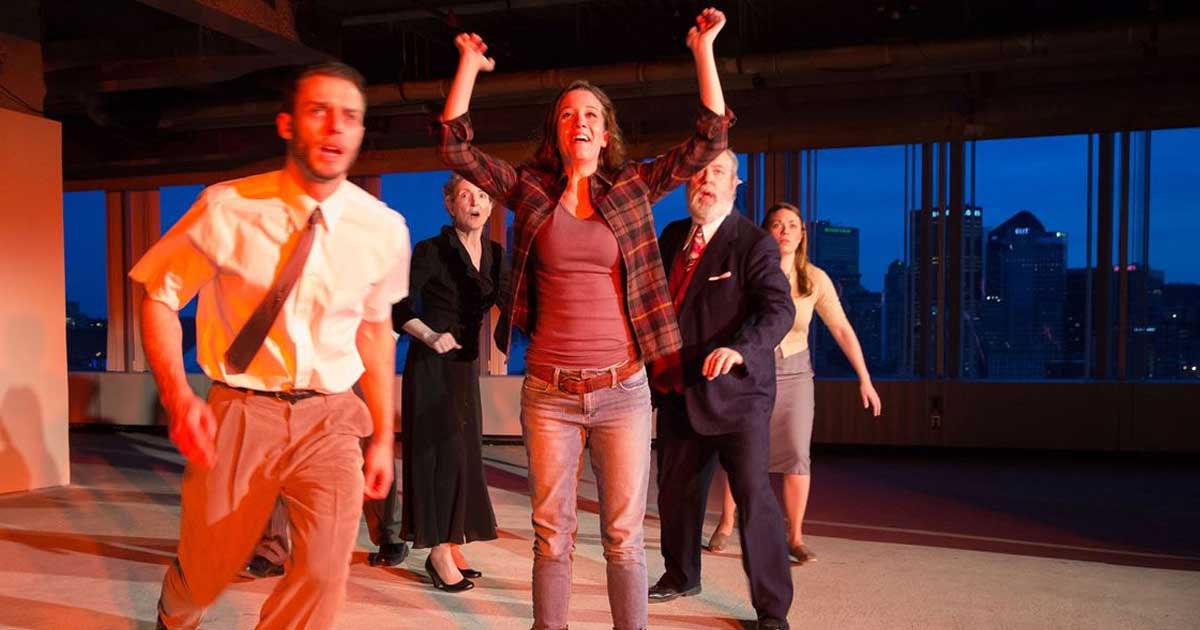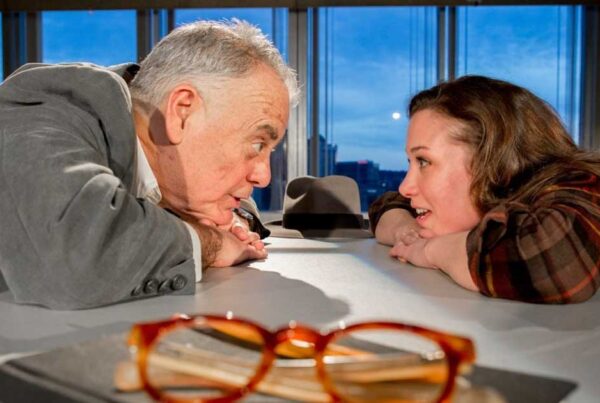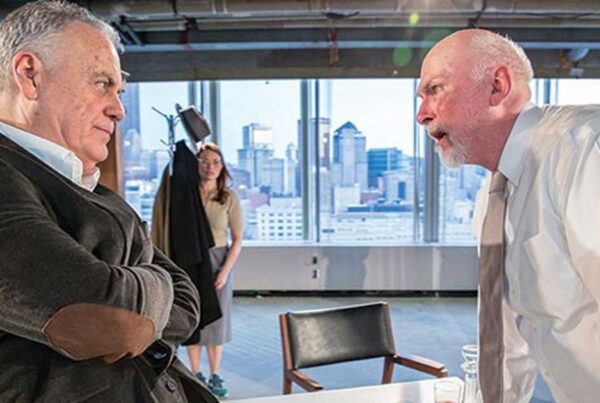
Pittsburgh Post-Gazette – The ninth floor of 2 Allegheny Center displays the sort of stunning views you see in movies where the wealthy protagonist lives in a window-encased luxury high-rise.
The vistas had long been lonely for admirers before becoming temporary home to Quantum Theatre for its latest production, Henrik Ibsen’s “The Master Builder.” Audiences can share Quantum’s enviable perch when the play opens Friday, along with learning how ideas expressed in the play mesh with themes being explored by the Carnegie Museum of Art’s Heinz Architectural Center.
“The Master Builder,” first published in 1892, here is set in the 1950s, to fit in with the center’s current deep dive into Modernism in Pittsburgh, including exhibitions of “a mid-century industrial city brimming with innovative architecture and design.” The cityscape view and the play at hand will be in particular harmony when young Hilda (portrayed by Hayley Nielsen) asks title character Harvald Solness (John Shepard) to deliver on his promise of building “castles in the air,” with the spires of PPG Place visible as a backdrop.
Before this production, Quantum leader Karla Boos and director Martin Giles had collaborated on Ibsen works such as 2003’s “The Wild Duck” and 2013’s “John Gabriel Borkman.”
“In our many Ibsen discussions, ‘The Master Builder’ was always kind of hovering on the fringes of, ‘This is a crazy one to do,’ ” Ms. Boos said. “It was galvanized by the collaboration between the Heinz Architectural Center and the whole idea that we would contribute to their conversation about modernism. So I started kicking around ideas with Ray Ryan about letting the Quantum project bring people into a modernist building.”
Raymund Ryan, curator of architecture at the Heinz Architectural Center, is overseeing “HACLab Pittsburgh: Imagining the Modern.” In partnership with HACLab, Quantum will host a series of discussions centered around Pittsburgh’s modern architecture, in a place where the speaker may point to buildings on the agenda.
“I think it’s cool we are in a building that’s controversial, too,” Ms. Boos said of 2 Allegheny Center, the tallest building immediately overlooking the mall.
It’s a vantage point that affords views of the old and the new — from the Carnegie Library building that opened in 1890 to glossy mid-century structures such as Gateway Center and the former Alcoa building, and the sweeping lines of the roof of the David L. Lawrence Convention Center, which ushered in the 1980s.
Allegheny Center today is in the early stages of a transformation into Nova Place, a campus for high-tech companies.
“We started to see parallels with the modernist idea about new ideas superseding old ideas — like, this place was supposed to be a positive change for a neighborhood, and maybe in some ways it was, and in others it wasn’t,” Ms. Boos said. “It’s considered a failed urban planning project. And now, for sure, it’s got these fabulous people who are both respecting it as a piece of architecture and envisioning change yet again that can revolutionize this neighborhood.”
The 19th-century play chosen to mesh with modernist views was recently performed at London’s Old Vic as a vehicle for Ralph Fiennes, who described Ibsen’s themes as “wacky and crazy” and “essential and eternal.” The production, a new translation by David Hare that also starred Linda Emond and Sarah Snook, is looking for a Broadway theater to become available for a fall opening. The previous Broadway revival was 1992.
“Here you have a man who is past his prime, so his sense of mortality is strong and his sense of his fading creative power is strong,” the actor said in a video interview for the Old Vic. “And here comes this girl, she’s 23, and she brings in this sort of youthful creative force, but it becomes in a way of a power play between them. It works like a psychological thriller.”
Solness is referred to as a “master builder” instead of an architect because he has learned on the job. He has suffered a great loss and become insufferable to everyone in his path. As his grip on reality seems to be slipping away, his inflated sense of self is challenged by fears that “the next generation will come knocking at my door.” Youth does come knocking, in the form of 23-year-old Hilda, who 10 years earlier had become entranced watching Solness christen the steeple of one of his buildings with a wreath. He then promised to build her that castle in the air, and she arrives, like a breath of fresh air, to collect on the promise.
The play is awash with mythological references, unsettling visions and tragic memories. For Ibsen enthusiast Giles, “The Master Builder” counts among the master playwright’s most mysterious works, one in which “the unconscious surfaces in people’s behavior and what they say and their way of relating to the world,” he said. “Ibsen is the earliest modern. Every modernist writer worth his salt — like Joyce, and Pound, and Beckett, and Elliot — were all huge admirers of Ibsen, all understanding Ibsen led them to where they were.”
The man at the center of Quantum’s production is John Shepard, a veteran actor, educator and director. “The Master Builder” brings his career full circle — his first acting gig was at the Oregon Shakespeare Festival, as Hjalmar Ekdal in “The Wild Duck.”
“Marty and I did ‘Hedda Gabler’ together for PICT, so I’d done a couple of Ibsens, but I’d never read this one,” Mr. Shepard said. “So I read it, and it scared me. I’ve been learning the lines for almost five months — that’s what gives you pause. Do I want to spend my entire life with this? But oh my God, it’s a great play and a great part. I’m so lucky to have this role and that he’s [pointing to Mr. Giles] the one directing.”
Finding the humor in the piece has been a source of solidarity for director and actor, and Solness’ bad-boy behavior has put a twinkle in everyone’s eye. In one way, Mr. Shepard as the master builder is typecasting — Solness’ fear of heights is a key plot point, “and I’m afraid of heights,” Mr. Shepard admitted.
As he spoke, the Quantum trio of director, star and artistic director were seated in a semicircle on what will be the staging area, facing the cityscape view.
The sunny scene at 5 p.m. is a beaut, but everyone agrees the sunsets that occur later in the evening are amazing.
With a play in three acts, there will be ample opportunity for the audience to explore the space and the views from all sides.
“When I came in, the first thing I thought was, it’s a cyclorama, because you can go all the way around it,” Mr. Giles said. “So I said [jokingly], ‘Can we make the building turn around,’ and they said, ‘No, stupid.’ So I thought, ‘We should make the play move.’ ”
Using minimalist furniture and props, set designer Tony Ferrieri and Mr. Giles devised a plan that will have pieces from other acts within view during the action in another act, then moved front and center when their time comes.
“It’s these little installations that all move,” Mr. Giles said. “When people arrive, they get to walk past a little gallery of what they are going to see. Then we use the two short intermissions to make the changes happen.”
Design Wise Medical
We provide Help for Children through the creation of child-appropriate health products that allow them to live life to its fullest.
We inspire Hope for Families by developing solutions for the unique needs of children that others ignore due to limited profit opportunities.
We are DesignWise Medical, a volunteer based, technology driven, child focused, non-profit organization….Read more




